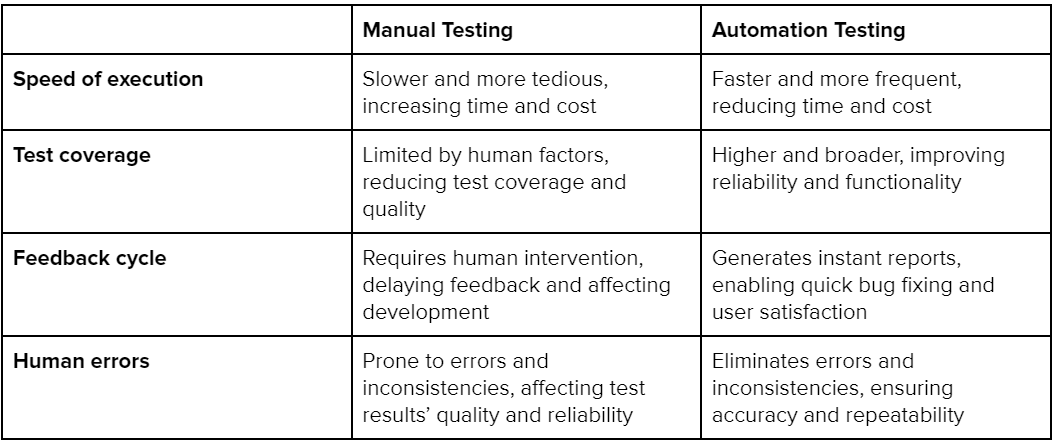Automated testing uses software tools to execute predefined cases on an application. Then, it compares the actual outcomes with the expected ones & generates reports. Thus, it can help your software development teams improve their products' quality, speed, and efficiency. But test automation also has some challenges/limitations. These must be considered before implementation.
Thus, in this article, we’ll explore the drawbacks & benefits of automated testing. We’ll also answer some frequently asked questions at the end of the article.
Pros and Cons of Automated Testing
5 Benefits of Automated Testing
There are several benefits of automated testing over manual testing, including:
Saving costs and resources in the long run
It reduces the need for manual testers and repetitive tasks, saving you time, money, and hassle. A white paper by PwC shows a sample business case where test automation reduced the costs by 40% and the defect fixing costs by 47%. It also helps you avoid the expenses of fixing bugs that might occur later in the development cycle or after deployment.
Providing faster feedback and bug detection
According to Perfecto, the manual method is the most time-consuming activity in the cycle. In contrast, test automation allows you to run them quickly and frequently, which helps you get instant feedback on your software’s functionality and usability. This enables you to detect and fix issues early on. Thus, the user experience and customer satisfaction are improved. Automation testing also supports agile development methodologies, which require fast and continuous feedback loops.

Increasing test coverage and depth
Test automation enables you to check more features, scenarios, and complex use cases that manual techniques might overlook or skip. This ensures that your software is thoroughly tested and meets all the requirements and specifications. Also, you can write more in-depth tests that check the internal aspects of your software, including memory, data tables, and file contents.
Enhancing reliability and accuracy
Test automation eliminates human errors and inconsistencies that might occur in manual testing. It ensures that your tests are executed the same way every time, increasing the reliability and accuracy of the results. Also, the risk of missing or forgetting some test cases or steps is reduced, which might affect the QA testing of your software.
Supporting continuous integration and delivery
Test automation enables you to run tests automatically whenever a code or environment changes, ensuring that your software is always ready for deployment. It also helps you integrate your tests with other tools and processes, including version control, bug tracking, and reporting. This streamlines the delivery of your software project and reduces the time to market.
3 Drawbacks of Automated Testing
Besides the benefits of automated testing over manual testing, it also has some disadvantages:
High initial investment
Setting up and maintaining the automation tools, frameworks, and scripts requires significant time and resources. It also requires skilled and experienced testers who can design, develop, and execute adequate automation test cases. This increases the upfront cost of test automation compared to manual testing.
Limited scope
Test automation cannot completely replace manual testing. That’s because human judgment & evaluation are needed for some aspects of software quality. This includes usability, accessibility, and aesthetics. It also cannot handle dynamic and unpredictable scenarios that may arise during software usage. For example, some visual components/user interactions need manual verification. Thus, automation techniques are unable to test them.
Technical challenges
Test automation may encounter technical issues/limitations that affect its performance or reliability. These issues may need manual intervention or troubleshooting to resolve them. This includes:
- Compatibility with different browsers, platforms, or devices;
- Changes or updates in the software application;
- Bugs or errors in the automation tools or scripts.
When To Use Automation Testing?
After judging the drawbacks and benefits of automated testing, it is clear that it is unsuitable for every situation or project. Instead, it depends on various factors.
Type of Software Application
Some software applications are more suitable for test automation than others. For example, web apps with a stable user interface and numerous users are good candidates. In contrast, mobile apps with frequent changes and a diverse range of devices are more challenging.
Type of Test Case
The suitability also depends on the type of case. For instance, regression tests verify the functionality of existing features after updates. Thus, they’re good candidates. On the other hand, it is better to use the manual approach for exploratory tests that discover new features.
Cost-Benefit Analysis
The decision to use test automation should be based on a cost-benefit analysis. This compares the expected benefits of automated testing with the required costs of implementing it.
The benefits of automated testing include:
- Faster execution time,
- Higher coverage,
- Instant feedback,
- Reduced human errors.
The costs of this method include initial investment, limited scope, and technical challenges.
Frequently Asked Questions (FAQ)
Here are the answers to some common questions.
Can We Automate All Test Cases?
No, we cannot automate all test cases. As mentioned above, some aspects of software quality need human judgment and evaluation. This includes usability, accessibility, and aesthetics. Others involve dynamic or unpredictable scenarios. These cannot be predefined or scripted by automation tools.
In conclusion, you should use a combination of automated and manual approaches to achieve optimal results.
How Many Types of Automation Testing Are There?
There are many types of test automation. But we can categorize them based on three main criteria. Each can be automated using different tools and frameworks:
- The scope: It ranges from individual components or units of code to the whole application. The four levels are unit test, integration test, system test, and acceptance test.

- The goals: This includes verifying the app’s functionality, performance, security, or compatibility. The three common purposes of testing are:
- Functional test;
- Non-functional test;
- Regression test.
- The approach:
- Black-box testing tests the application without knowing its internal structure and logic.
- White-box testing tests the application with the knowledge of its internal structure and logic.

Are There Any Differences Between Manual Testing and Automation Testing?
Yes, there are differences between automated and manual testing:

Conclusion: 5 Benefits of Automated Testing
It is a powerful and effective way to ensure your software product's quality and performance. However, it is not a silver bullet to solve all your challenges. Achieving the desired results requires careful planning, design, implementation, and maintenance. It also depends on your software project's type, scope, and complexity.
Also, if you are looking for a reliable and professional service provider, consider Golden Owl. We are a leading software development company that offers high-quality automation testing solutions for web and mobile applications.
Our team has successfully delivered test automation projects for clients across various industries, including e-commerce, education, healthcare, and finance. With us, you can enjoy all the benefits of automated testing without worrying about its technical details and challenges. To learn more about our services, don't hesitate to contact us today for a free consultation.





















